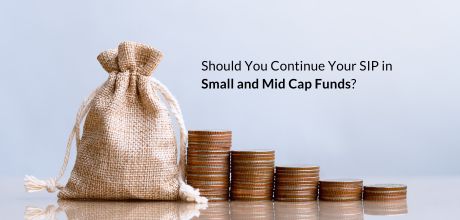Active and Passive Funds, How They Can Complement Your Portfolio

In the last few years, passive funds have become quite popular among investors. Some reasons for this include the number of passive funds launched by AMCs, wider awareness about them, their performance and benefits, etc.
As a result, the common question among many investors is whether they should prefer passive funds over active funds. In this article, we will discuss how both these kind of funds can co-exist and complement your investment portfolio.
What Are Active Funds?
An active fund is a mutual fund scheme in which the fund manager decides which company shares to buy, the quantity, when, and at what price. Similarly, the fund manager decides which company shares to sell, the quantity, when, and at what price. The fund manager is assisted by a research team that evaluates stocks on various parameters for buying or selling them.
So, as the name suggests, the mutual fund scheme is actively managed by the fund manager. The objective is to outperform the benchmark index and create wealth for the investors.
What Are Passive Funds?
A passive fund replicates or mirrors the performance of a benchmark index. It invests in all the index constituents in proportion to their weight in the index. The fund manager has no say in which company shares to buy/sell, the quantity, when, and at what price.
Whenever the benchmark index is reconstituted, the index fund follows it. The shares of the company excluded are sold, and the shares of the new company included are bought. The objective is to mirror the performance of the benchmark index as closely as possible and not to outperform it.
Active vs Passive Funds - What’s the Difference
Table: Active funds vs Passive funds
|
Active Funds |
Passive Funds |
|
Investment is made based on the premise that markets are inefficient and there is scope to generate alpha. |
Investments are made based on the premise that markets are efficient and beating them in the long run is difficult. |
|
The fund manager creates a hand-picked portfolio and manages it actively. They follow a hands-on approach. |
The portfolio comprises stocks that are a part of the benchmark index. They follow a buy-and-hold approach. The inclusion or exclusion of stocks in the portfolio is based on their inclusion or exclusion in the benchmark index. |
|
The expense ratio for active funds is usually on the higher side compared to passive funds. |
The expense ratio for passive funds is usually lower than for active funds. |
|
The performance can be better, in line, or lower than the benchmark index. |
The performance is usually in line with the benchmark index, with some difference on the lower side due to the expense ratio and tracking error. |
|
The fund manager has the flexibility to make portfolio changes based on the expected overall market performance, individual company performance, and other factors. |
The fund manager doesn’t have the flexibility to make portfolio changes even if they believe the overall market and/or individual companies may underperform. |
Now that we understand the difference between active vs passive funds let us look at how they can complement each other in an investors portfolio.
Factors to Consider Before Investing in Active and Passive Funds
When it comes to choosing between active investing vs passive investing, some of the factors that investors consider include the potential to outperform the benchmark, the expense ratio, fund manager’s scope to make portfolio changes, etc. Investors usually pay a higher expense ratio for active funds as they expect the fund manager to outperform the benchmark and generate superior returns for them.
Investors may consider passive funds in the large-cap category. Considering the costs involved, wide coverage of large-cap stocks, etc., active large-cap fund managers may find it difficult to beat the benchmark. So, investors may consider investing in large-cap index funds through the systematic investment plan (SIP) route.
On the other hand, within the mid and small-cap stocks category there are stocks that are still not fully discovered or their growth potential has still not been fully recognised by the market. In these categories, fund managers have scope to spot these hidden gems and generate superior returns for their investors. So, investors may consider investing in active mid and small-cap funds as there is good scope to generate superior returns compared to the benchmark.
When markets are falling or are in correction mode, the passive funds usually see a relatively lower drawdown compared to active funds. It makes a case for having passive funds in the portfolio and thus have an overall balanced portfolio with a mix of active and passive funds.
For long term financial goals, investors may consider having higher exposure to active mid and small-cap funds. Thus, a strategy of building a diversified portfolio with a mix of active and passive funds will go a long way in helping an investor fulfil their financial goals and achieve financial freedom.
Active and Passive Funds Can Co-exist in Your Portfolio
Instead of considering active vs passive mutual funds, investors may consider a combination of active and passive funds. You can make a portfolio of passive large-cap funds and active mid and small-cap funds. With such an investment strategy, active and passive funds can co-exist in your investment portfolio and you can get the best of both.
FAQ's
Why Is the Expense Ratio of Active Funds High?
In an active fund, the fund manager and their research team keep evaluating the performance of existing companies in the portfolio and others. It is a time-consuming job and requires a full-time research team for it. Also, the regular buying and selling of stocks involves brokerage, Government levies, and other charges. The active fund has to incur expenses to meet the above costs. Hence, the expense ratio of active funds is usually higher than passive funds.
What Are the Types of Passive Funds?
The types of passive funds include Exchange-traded Funds (ETFs) and index funds. The ETF units are listed on the stock exchange (NSE) like company shares. The buying and selling of ETF units happens during market trading hours through the trading account provided by a broker. The ETF units bought are credited to the demat account.
The index fund units can be bought from the AMC. You can use the systematic investment plan (SIP) mode for regular monthly investment over the long term. The index fund units are credited to your folio without the need for a demat account. You can redeem the units with the AMC whenever you want without any liquidity issues.
What Is a Benchmark Index?
A benchmark index is one that a passive fund aims to replicate or mirror. Some well-known benchmark index examples include the Nifty 50, Nifty Next 50, Nifty Midcap 150, Nifty Smallcap 250, etc. The active fund manager aims to outperform the benchmark index.
Your Investing Experts
Relevant Articles
How To Select The Best Mutual Funds For Long Term Goals
Mutual funds offer a compelling way to invest for long-term goals, leveraging professional management and diversification to potentially achieve significant returns. But with a vast array of options available, selecting the best mutual funds for the long term can feel daunting. This guide will equip you with the knowledge to confidently navigate the mutual fund landscape and learn how to select the best mutual fund aligned with your long-term aspirations.
Should You Continue Your SIP in Small Cap Mutual Funds
Investing in small cap funds requires patience and discipline, especially during market corrections. By staying committed to your SIPs and focusing on long-term goals, you can leverage the power of rupee cost averaging and compounding. Don’t let short-term market noise dictate your strategy—remain focused, stay the course, and trust that your disciplined approach will yield results over time.
Systematic Withdrawal Plans (SWP): A Reliable Way to Generate Regular Income
An SWP allows investors to withdraw a predetermined amount from their mutual fund investments at regular intervals, such as monthly, quarterly or annually. The beauty of SWPs lies in their flexibility—they provide consistent income while allowing the remaining investment to continue growing.



_(2).jpg)